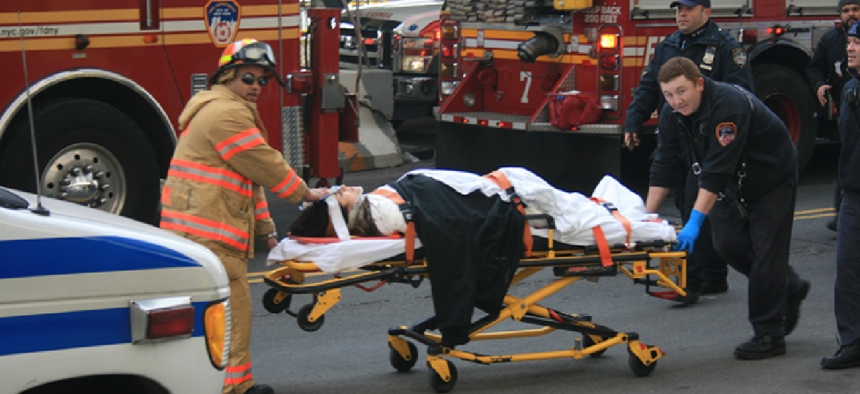Keeping tabs on responders’ mental health


Connecting state and local government leaders
After responding to more than double the typical number of deaths in the past 18 months, the Harris County, Texas, Northwest Volunteer Fire Department began using a cloud-based employee behavior and performance tool to more easily track and follow up with responders attending to critical incidents.
Responding to more than double the typical number of deaths in the past 18 months was taking a toll on the mental health of the 96 responders at the Northwest Volunteer Fire Department (VFD) in Harris County, Texas.
“It was COVID. It was the fact that we were locked down. People were in some of their darkest times. They were losing their jobs, so our suicides increased drastically as well,” said VFD Fire Chief Wesley Cole. “At the height of this -- and I would call the height about two months ago, where we had this new variant of COVID -- I had one first responder in a 30-day period who responded to 12 deaths and another to 14. We wanted to be able to track this and make sure that we’re cognizant of what our people were responding to and what they might be dealing with.”
Mental health was largely unaddressed at the department, Cole said, but in March 2020, it began using Envisage Technologies’ Acadis Early Intervention, an employee behavior and performance tool, to track the number of critical incidents that responders attended to. VFD defines a “critical incident” as one involving a death, when a death is imminent, when there’s a debilitating injury or when the incident involves something that would weigh on a responder, such as a child abuse case. To date, it has tracked about 1,100 critical incidents.
(Acadis was formerly Guardian Tracking, which Envisage Technologies acquired in March.)
The cloud- and web-based solution does not integrate with other department reporting tools. Instead, responders must log in and self-report any incidents. That kicks off a workflow in which their supervisors get an email alerting them to a new entry. When a responder reports three or more critical incidents within a 30-day period, a box pops up for supervisor requiring some form of early intervention – ideally, speaking with the responder in person to see how they’re doing.
“They must click on it and it won’t go away until they do something,” Cole said. “That supervisor has to write something to acknowledge receipt and what resulted.”
For instance, if the responder needs time off, VFD approves it. The department also partnered with a local counseling service that responders can voluntarily use.
Until implementing Guardian Tracking, VFD responders had to fill out paperwork about critical incidents. That went to the main office to be scanned in. “By the time [a supervisor] saw any of this, it could be a couple weeks or maybe even upwards of a month or two,” Cole said. “We decided that was too long and that we needed to be able to track this almost by the minute, the hour, the day,” he said, adding that a day “was pretty much the maximum that we wanted to allow.”
The system does four main tasks, Envisage Technologies’ CEO Ari Vidali said: documenting, analysis, notification and providing accountability. Customers, such as VFD, can set flags for X incidents within Y time frame, and when those parameters are met, the system emails notifications to appropriate parties.
It allows documentation of feedback, daily observation reports and customized events for each responder. Leaders, supervisors and firefighters can keep track of next steps in one location. For instance, at an annual review, a supervisor can see everything a responder has done.
Basically, the system ingests data and calculates patterns that humans would take a longer time to notice, Vidali said. “Once you have metrics, you can actually move those metrics in the right direction by taking specific actions on it,” he said.
To use the system, customers just need web access. Because it’s in the cloud, “we provide a higher level of security, and we provide scalability that is very difficult for individual departments to do on their own,” Vidali said. “We can provide centralized expertise for administering systems, maintaining systems, backing up data, which would be hard for each department to have a whole IT section to do all that. It really creates economies of scale and additional security.”
The system doesn’t track only bad news, he added. Responders can also note when they get positive feedback or save a life. For example, Cole said, if a community member calls to commend a team on their performance at a scene, he enters that into the system.
This feeds into mental health, too, Vidali added -- “Yes, we saw 10 deaths, but we also saved 30 lives.”
The company is working on integrating Guardian Tracking with other reporting mechanisms -- for instance, bringing in data directly from a computer-aided dispatch system and using it to populate reports. Integrating with human resources and training is also on deck, Vidali said. That way, someone whom the system predicts is suffering from post-traumatic stress disorder could automatically receive links to information on resources.
At VFD, the system is helping to normalize discussions about mental health, Cole said. “Now it’s becoming a forefront issue,” he said. “We are more aware of what’s going on with our employees.”




